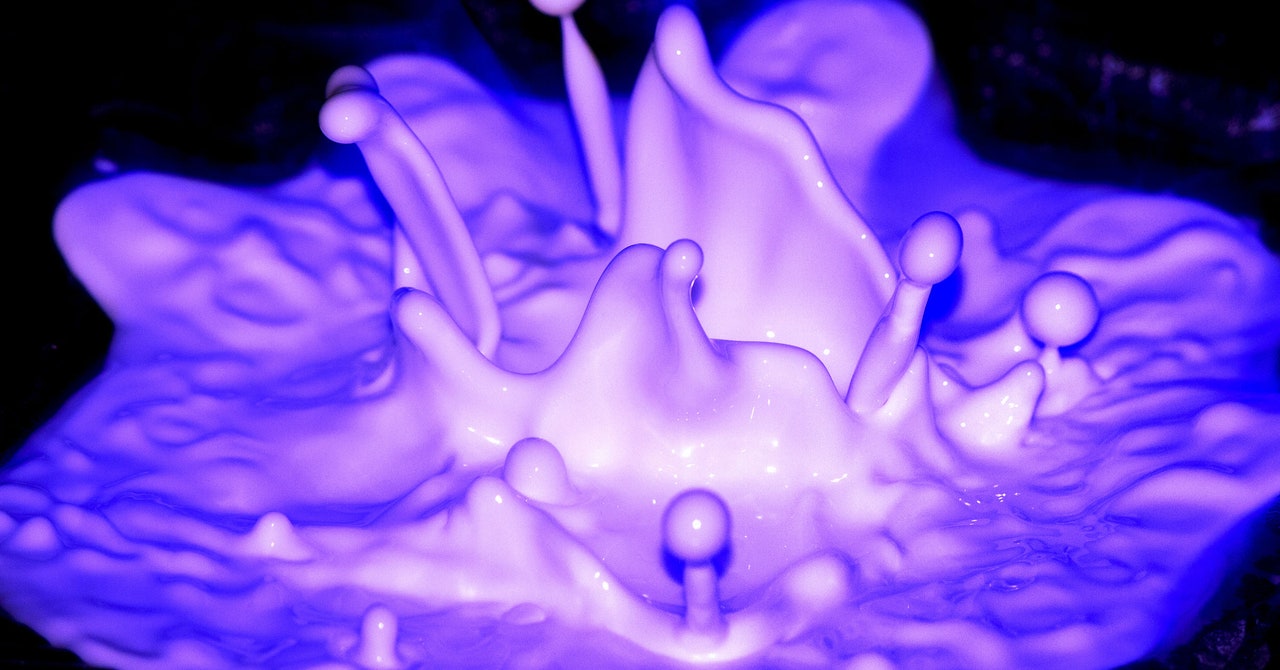
Fluids can be roughly divided into two categories: regular ones and weird ones. Regular ones, like water and alcohol, act more or less as expected when pumped through pipes or stirred with a spoon. Lurking among the weird ones—which include substances such as paint, honey, mucus, blood, ketchup, and oobleck—are a vast variety of behavioral enigmas that have stumped researchers over the centuries.
One such long-standing puzzle, first articulated nearly 55 years ago, arises when certain liquids stream through cracks and holes in a porous landscape such as spongy soil. At first the liquid will flow normally. But as its flow rate increases, it will pass a critical threshold where it will suddenly seem to coalesce—its viscosity shooting up like a martini turning to molasses.
A new study pins the effect on tiny molecules suspended in the fluid that whirl and stretch as the flow rate ticks up. At some point, the molecular motion causes the fluid flow to become chaotic, surging and rippling in convoluted eddies that loop back on themselves. The onset of chaos is what impedes the fluid’s movement. The finding could have applications ranging from 3D printing to groundwater remediation and oil recovery.
“This is a beautiful manuscript,” said Paulo Arratia, who studies complex fluids at the University of Pennsylvania and wasn’t involved in the work.
In the 1960s, the rheologist Arthur Metzner and his undergraduate student Ronald Marshall were working on oil fields, where engineers would often inject water mixed with so-called pusher fluids into the ground to displace the oil and help extract every drop of crude. The scientists noticed that when the pusher fluid, which contains long-chain polymers, was pumped into the ground above a certain rate, it seemed to unexpectedly become much more viscous, or sticky, an effect later found in many similar systems.
“Viscosity is one of the most important things you want to be able to predict and control and characterize,” said Sujit Datta, a chemical engineer at Princeton University who came across Metzner and Marshall’s 1967 paper on the subject as a graduate student. “I was like, ‘This is kind of embarrassing that even after decades of profound research we still have no idea why the viscosity is what it is, and how to explain the increase.’”
Pusher fluids and other viscoelastic fluids, as they’re known, can contain long, complex molecules. At first, scientists thought that perhaps these molecules were piling up in pores in the ground, gunking them up like hair in the drain. But they soon realized that these weren’t simple clogs. As soon as the rate of flow fell below a critical threshold, the obstruction seemed to disappear completely.
A turning point came in 2015 when a group at the Schlumberger Gould Research Center in Cambridge, England, simplified the problem. The researchers built a two-dimensional analogue of sandy soil, with submillimeter-size channels leading into a labyrinthine array of cross-shaped pieces. They then pumped fluids containing different concentrations of molecules through the system. The team noticed that above a certain flow rate, the fluid’s movement became messy and disordered in the spaces between the crosses, greatly slowing the liquid’s overall motion.
In theory, something like this should be almost impossible. Regular fluids are heavily influenced by inertia, their tendency to keep flowing. Water, for example, has a lot of inertia. As water moves faster and faster, small streams within the flow will start to outpace other sections of the fluid, leading to chaotic eddies.
A complex fluid like honey, by contrast, has very little inertia. It will quit flowing the moment you stop stirring it. Because of this, it has trouble generating “inertial turbulence”—the ordinary kind of turbulence that happens in a rushing stream or beneath an airplane’s wings.


